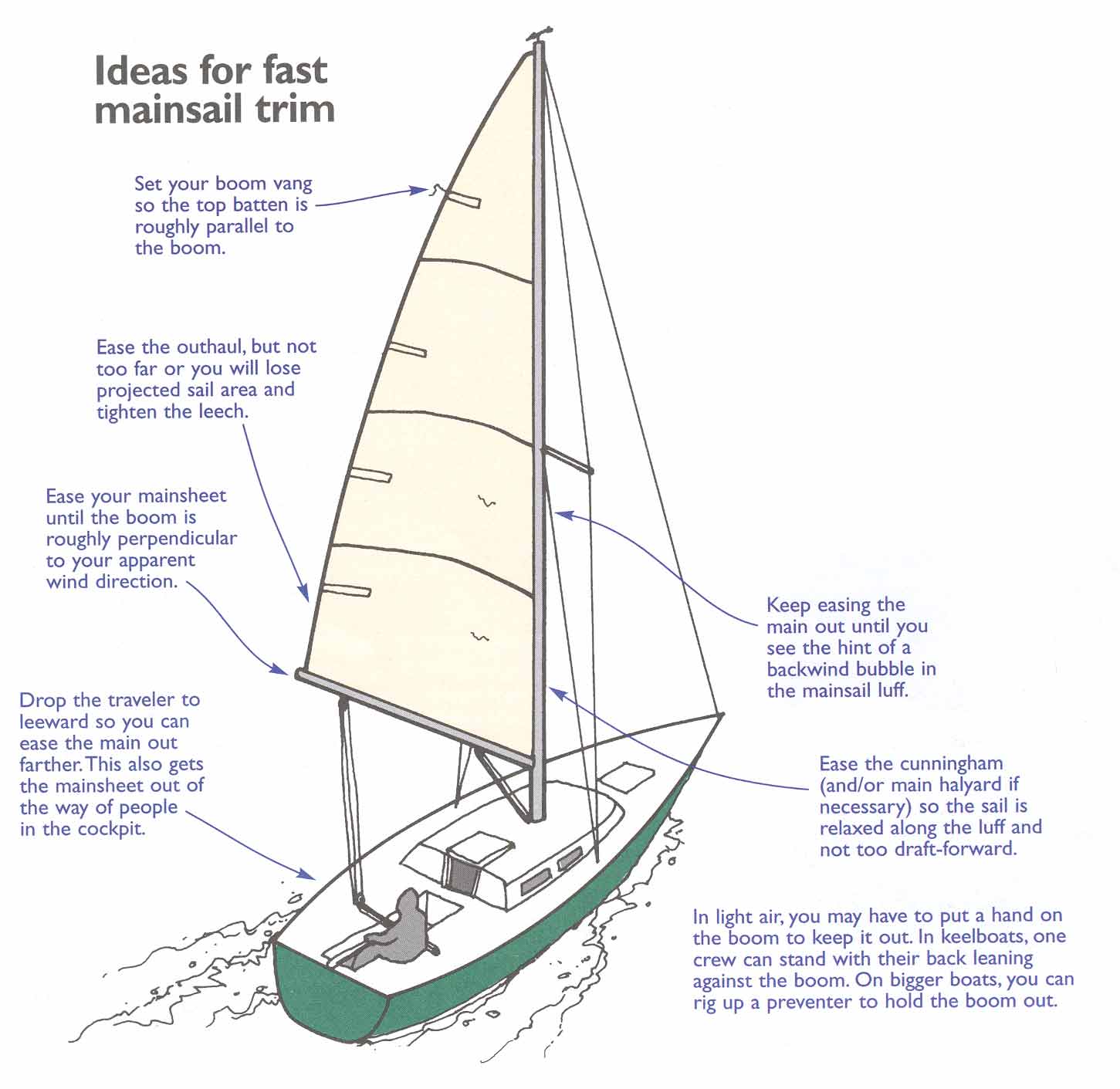 |
Trim Your Main for Speed on Runs
by David Dellenbaugh
When youíre racing downwind, good spinnaker trimming will make a huge difference in your overall speed. But donít forget about your mainsail. Too many sailors round the windward mark, let the mainsheet out, and then leave the main alone. But on many boats the mainsail is acutally bigger than the spinnaker (or there may not even be a spinnaker!). So if you want to go fast, you have to keep working hard to fine-tune your mainsail trim.
The two basic rules of thumb for
trimming a mainsail are almost identical
to those for a spinnaker: 1) Always let
the sheet out as far as possible; and 2)
Keep adjusting the sail constantly for
changes in wind velocity or angle.
 |
Common trimming errors
Itís not usually too hard to get your
mainsail trim in the right ballpark when
you are running. There are, however, two
mistakes I commonly see. Both are very
slow.
The first error is overtrimming the
mainsheet. This is bad because you lose
projected area in the sail. Basically,
you want the boom (and therefore the
chord of the sail) to be roughly
perpendicular to your apparent wind.
To find the right position, ease the
sheet out until either a) you see a
bubble along the front of the sail (at
which point you should trim it back
slightly to remove the bubble); or b)
the boom hits the leeward shroud(s); or
c) the boom reaches an angle of roughly
90į to (the centerline of) the boat.
To avoid overtrimming the main, donít
cleat the sheet. Though the mainsheet is
often eased as far as possible during
the run, there are always small changes
in wind angle or pressure that might
require a trim change. If the mainsheet
is cleated, odds are that it will be
forgotten and seldom adjusted.
The second common error is using too
much vang downwind. Itís easy to
over-vang on a run, but in most cases
you want only enough tension on the
mainsail leech so the top batten is
parallel to the boom. If you pull down
too hard, the top batten(s) will hook
windward. This reduces projected sail
area and will kill any air flow that
might be happening around the top part
of the sail. Too much vang is a little
like overtrimming the sail. It is
usually quite slow, especially when you
have light air or lumpy seas.
Another time you definitely want a
looser vang is when youíre sailing a
boat where the leeward shroud prevents
the boom from going out all the way. In
this case you cannot get the bottom of
your sail perpendicular to the apparent
wind. By easing the vang, however, you
allow the top of the mainsail to rotate
forward so it may be 90į to the wind.
This trim is fast.
Other mainsail trimming tips
Beyond easing the sheet out far enough
and not tensioning the vang too hard,
there are several things you can do with
the main to make your boat go faster on
runs.
ē In lighter air you may have to hold
the boom out, especially if you are
heeling to windward. When you do this,
try not to pull down on the boom since
this will likely create too much leech
tension.
ē Trimming the mainsail and spinnaker
often go hand in hand. For example, when
you ease the spinnaker sheet you may be
able to ease the mainsheet, too. If the
two trimmers communicate, they can often
help each other.
ē On smaller boats, many helmspersons
play the the main by holding the sheet
directly as it comes from the boom. By
skipping the ratchet block you get a
better feel for the sail, plus itís
easier to pump it out and let the sail
out.
ē You almost always want less mainsail
luff tension on a run than on a beat.
This is partly because the mast gets
straighter downwind and you donít need
luff tension to pull the sailís draft
forward. In fact, you want the draft
further aft so you should ease the
cunningham completely and even lower the
halyard if necessary to get a nice fair
shape in the sail.
ē The air flow around the mainsail is
mostly stalled when youíre sailing
downwind, so donít rely on telltales
(either on the leech or near the front
of the sail) to give you much
information about trim.
Dave publishes the newsletter Speed &
Smarts. For a subscription call:
800-356-2200 or go to:
www.speedandsmarts.com